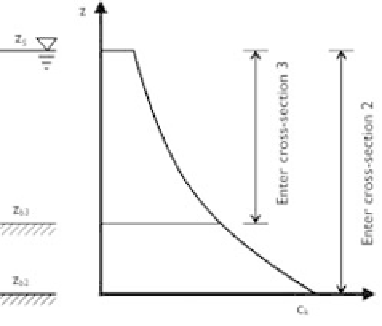Geoscience Reference
In-Depth Information
For the confluence shown in Fig. 5.9, the suspended-load concentration
C
k
,3
and
bed-load transport rate
Q
bk
,3
at cross-section 3 can be calculated using the following
mass balance equations:
C
k
,3
=
(
Q
1
C
k
,1
+
Q
2
C
k
,2
)/
Q
3
(5.161)
Q
bk
,3
=
Q
bk
,1
+
Q
bk
,2
(5.162)
where
C
k
,1
and
C
k
,2
are the suspended-load concentrations and
Q
bk
,1
and
Q
bk
,2
are
the bed-load transport rates at cross-sections 1 and 2, respectively, which are known
from the previous calculations in channels 1 and 2.
For the split shown in Fig. 5.10, the following mass balance equations exist:
Q
2
C
k
,2
+
Q
3
C
k
,3
=
Q
1
C
k
,1
(5.163)
Q
bk
,2
+
Q
bk
,3
=
Q
bk
,1
(5.164)
which, however, cannot uniquely determine
C
k
,2
,
C
k
,3
,
Q
bk
,2
, and
Q
bk
,3
without
additional relations. For suspended load, the ratio of
C
k
,2
and
C
k
,3
can be determined
using Ding and Qiu's (1981) method. Fig. 5.15 depicts the vertical distribution of
suspended-load concentrations entering cross-sections 2 and 3. The bed elevations of
these two cross-sections are denoted as
z
b
2
and
z
b
3
, and their water stages are assumed
to be
z
s
. Suppose that cross-section 2 is in the main branch channel, i.e.,
z
b
2
z
b
3
.
It is assumed that the sediment concentration at cross-section 3 corresponds to the
upper layer above
z
b
3
in the distribution curve of cross-section 2. Therefore, the ratio
of
C
k
,2
and
C
k
,3
can be approximated as
<
z
s
z
b
2
+
δ
f
k
(
z
)
dz
C
k
,2
C
k
,3
=
z
s
(5.165)
z
b
3
f
k
(
z
)
dz
Figure 5.15
Sediment concentrations at channel split.


